1956 Belgian Grand Prix race report: Collins scores debut win
Ferrari's Peter Collins takes his first win in an exciting race, the Ferrari driver almost two minutes ahead of the nearest challenger
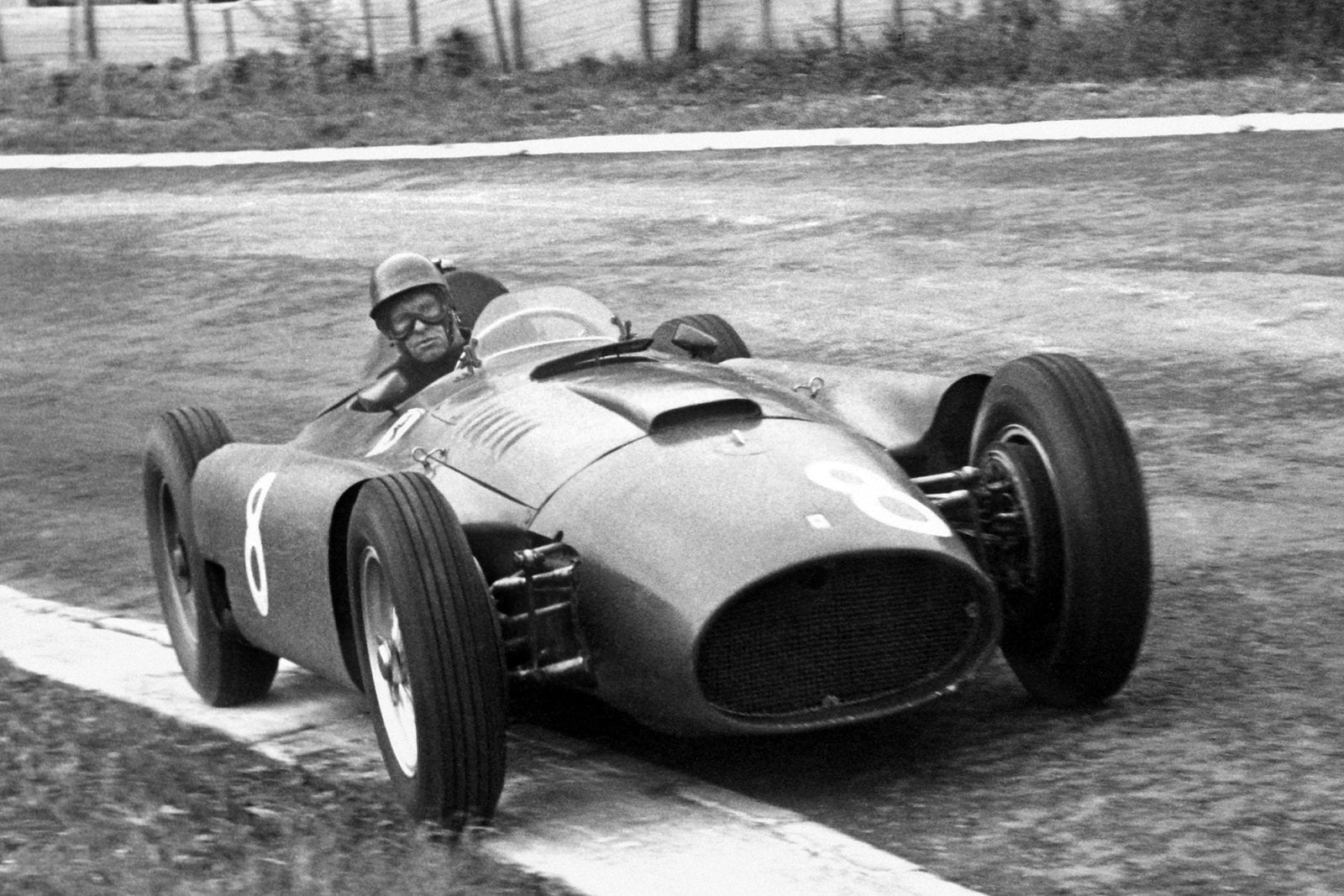
Motorsport Images
The permanent road circuit that lies within the triangle formed by the three villages Francorchamps, Malmedy and Stavelot, in the Spa region of the Ardennes, is one of the finest in Europe, and each year the Royal Automobile Club of Belgium organise their Grand Prix on this circuit. With its extremely high lap speeds, fast uphill and downhill corners, long sweeping curves, and its hairpin, it is one of the greatest tests for a Grand Prix car and driver, and really sorts out those who are in the Grand Prix class and those who are not.
Qualifying
This race is one of the more straightforward Grande Epreuves, unhampered by sideshows or other races, and each year three practice sessions are provided, the first two in the evenings of Thursday and Friday and the third on Saturday afternoon. The first session saw the Ferrari team out with two cars and Fangio, Castellotti and Collins as drivers, for Musso was absent following his accident the previous week at Nurburgring.
Maserati had three cars out, one the prototype ducted-radiator model, and all with carburetter engines, the three works drivers, Moss, Behra and Perdisa, changing cars frequently. Since, last year the corner at Malmedy has been completely resurfaced and the edges cleaned up so that a fast entry into the Masta straight is possible, while each year the long curve at Stavelot settles a bit more and becomes smoother and smoother. With these two improvements it seemed likely that faster laps than last year would be recorded, but at first the Maseratis were circulating a lot below the 4 min 20.6 sec recorded during last year’s race by Fangio with the Mercedes-Benz.
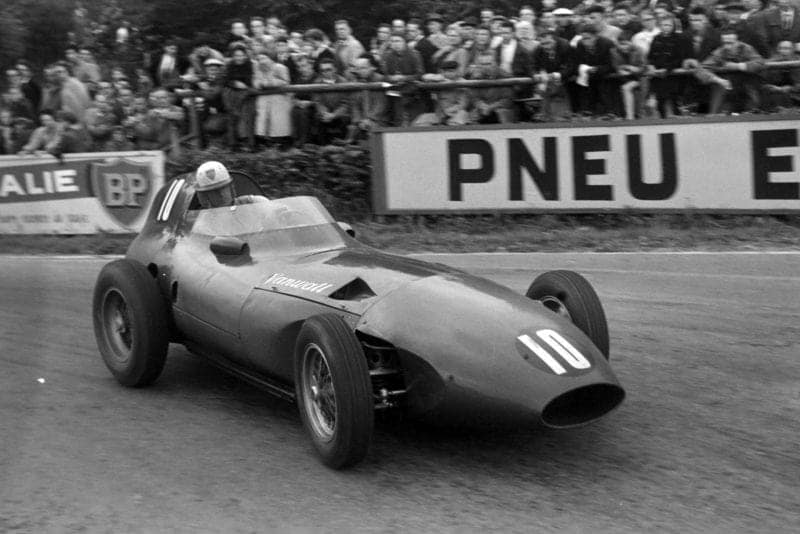
Harry Schell heads into La Source in his Vanwall
Motorsport Images
Although this counted as the lap record, Castellotti had done 4min 18.1sec in practice last year with the original D50 Lancia. The first intimation of the possibilities of this year’s cars was given when Fangio went out and within a few laps got below last year’s record and then surpassed the best ever with a lap in 4min 17.4sec. Castellotti went out in the other Lancia/Ferrari but kept having to stop for minor adjustments, and finally stopped altogether when a circlip came out of a half-shaft and let all the steel balls in the driving splines come out. As Fangio was monopolising the other car Collins did not get a drive.
Apart from those two works teams the only other car out was Gould’s Maserati, though the Connaught was there but without a driver. As the evening wore on all traces of wind dropped, the road was perfectly dry and the air became cold and very slightly damp, not enough to perceive but absolutely right for carburation on an unsupercharged engine.
“When the loudspeaker announced that Moss had done 4min 14.7sec everyone sat up and took notice”
Moss had been going round in just over 4min 20sec and then he started livening things up by recording 4 min 17.6 sec which made Fangio look up from the pit counter where he was sitting, and then when the loudspeaker announced that Moss had done 4 min 14.7 sec everyone sat up and took notice. This was a speed of 199.575 kph, and as the Continent count in hundreds the nearness to 200kph was electrifying.
This figure of a lap speed of 200kph is something dreamed of by all Continentals and means very much the same as 100 mph in Great Britain, except that it is a lot faster. As is becoming a recognised thing during Grand Prix practice, the moment anyone beats his time Fangio goes out again and sets a new high, but, now that Moss had knocked nearly 3 sec off Fangio’s best, a murmur ran round the pits that the “old boy” had met his match.
Moss came into his pit and Fangio went off, and as he disappeared up the hill towards the Burnenville Forest the tension around the starting area and pits could be felt. He had the whole circuit to himself, as had Moss, conditions were perfect and a short while later he could be heard approaching the hairpin prior to starting his first flying lap. Watches clicked everywhere, and as the blare of the eight megaphones on the Lancia engine died away into the woods once more everyone was tensed, waiting to “see if he could do it”.
In less than 4 minutes he could be heard coming up the return leg of the circuit towards the Club House bend before the La Source hairpin, round the hairpin came the squat Lancia/Ferrari, down the hill towards the pits, and “wham” he was past and down into the L’Eau Rouge corner. “Impossible,” everyone cried, “4 min 10.4 sec, he must have found a short cut!” But it was true, the official announcement came over the loudspeakers, and meanwhile the World Champion was on another even faster lap.
Once more the blast from the side-mounted megaphones swept the pit counters, blowing up the dust and nearly shattering eardrums, and in double-quick time announcer Jean Leroy demanded the official lap time, for his watch, like many others, said 4 minutes and less than 10 seconds. The timekeepers gave out the official time and it was the fantastic one of 4 min 9.8 sec, a speed of 203.490 kph.
This was 10.8 seconds faster than last year’s official record, and although the circuit was a bit faster no driver was prepared to allow more than 4 or 5 seconds benefit. There was no doubt that Fangio and the Lancia/Ferrari were right on top of their form, while Moss and the Maserati were not hanging about, especially bearing in mind that the car he had used was a hack one. Needless to say, practice for the day finished at that point, even though Moss went out again on another of the works cars, but it was not as fast as his first one.
During the night the rest of the entries arrived and the Friday practice saw everyone ready to start long before the official time of 6 pm, but unlike the day before the weather was now terrible and rain fell incessantly. Moss was soon out on the new sleek fuel-injection Maserati, Behra and Perdisa were driving the normal works Maseratis, and Hawthorn was out in one of the spare Modena cars.
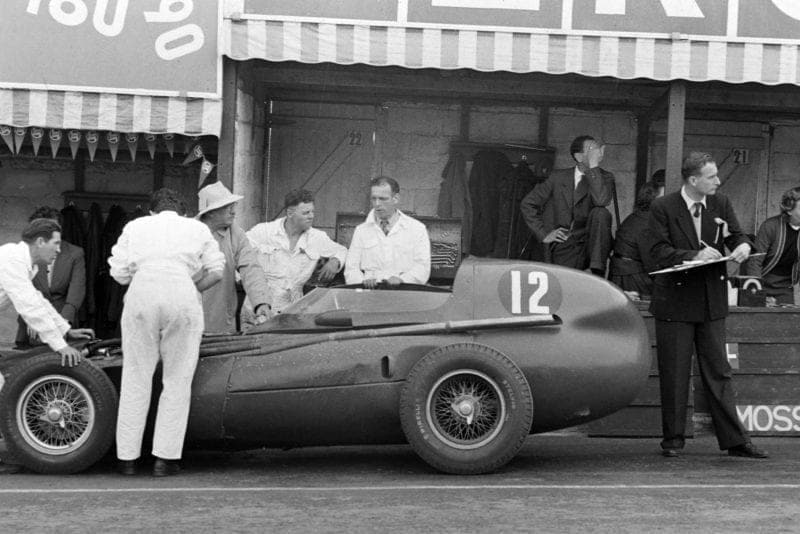
Trintignant’s Vanwall is seen to in the pits
Motorsport Images
As the BRMs were making another non-appearance, he had contracted to drive for Maserati for this race, but unfortunately he had also offered his services to Ferrari and before one team had given a reply the other had accepted so that there were some harsh things being said by the Ferrari team-manager. Fangio, Castellotti and Collins were all out in the rain, and now that Hawthorn was not taking the fourth car Paul Frere accepted the offer. The one being loaned to the Equipe National Belge was being driven by Pilette, as Gendebien had turned down the offer on the grounds of still being too inexperienced to tackle Formula 1 racing yet, especially on a circuit like Francorchamps.
Naturally, times were a lot slower than the previous evening, but nevertheless it was the same drivers who set the pace, and times around 4 min 40 sec were becoming regular. Castellotti was putting in a lot of practice and wound up with 4 min 39.9 sec, then Fangio did 4 min 39.0 sec, and once more Moss stirred things up with 4 min 37.7 sec. Not to be outdone, Fangio went out once more and did 4 min 36.3 sec, a time that was faster than many people could achieve in the dry. Frere put in some tentative laps getting the feel of the Lancia/Ferrari which he had not driven before and finally achieved a creditable 4 min 55.9 sec, this being his first Formula I drive since the Belgian race last year.
The two Vanwalls were not very happy, suffering front incorrect mixture and misfiring in the higher rpm range, while Godia and Scotti were groping their way round an unfamiliar circuit. Behra and Hawthorn could not approach the speeds of the top three, the Frenchman being a bit put out by this, while the Englishman did not mind, as his car did not fit him very well and he could not try hard. Collins did not get under 5 minutes and did a surprisingly small amount of practice, while Perdisa was hopeless on such a fast circuit, showing no improvement over last year. The continuous rain made things very drab and as darkness drew on it become cold and thoroughly miserable, so that everyone was ready to go home long before the official closing time of 8pm.
“No one could approach the times set up by Fangio on Thursday”
The last practice period was held from 3pm to 5pm on the Saturday before race day and once again the track was clear and dry, though there was a strong wind blowing up the Masta straight, so that no one could approach the times set up by Fangio on Thursday. The Vanwalls were now going well, but suffering from surge in the oil tank, having to run with the minimum of oil, and the injection Maserati was going well but proving to be very thirsty.
Castellotti was really trying and got below 4min 20sec and then did 4 min 17.1 sec, but Fangio bettered this with 4min 14.8sec, and put in a number of laps around this figure, trying hard and taking his front wheels over the grass verges, while his rear ones were sliding outwards under power.
Schell was beginning to show the paces of the Vanwall, knocking seconds off each lap, while Trintignant was following him closely. Frere was obviously enjoying the Lancia/Ferrari now the track was dry, and Behra began to make a big effort. Meanwhile, Perdisa was still touring round, no faster than Rosier, Villoresi was taking things quietly and Scotti was happily putting in lap after lap in his Connaught. Poor Godia blew up his nice new car before he had really become accustomed to the circuit, and Schell brought him back to the pits on the tail of his Vanwall.
Gould was more worried about bursting his car on such a fast circuit than making a good time, and Pilette was rather slow with the Lancia/Ferrari. Collins was still doing very little practice, though Fangio and Castellotti were going round and round, both giving all they had got. Towards the end of the afternoon Fangio was fastest with 4min 14.4sec, then came Moss with 4 min 14.8 sec, the strong wind holding them back down the straight, and Castellotti was third fastest with 4 min 16 sec.
Behra kept trying and gradually carved his time down until he equalled Castellotti’s time, and then Collins went out and in a very few laps upset both of them by making third fastest of the day with 4 min 15.3 sec, and considering how little practice he had been doing, this was a most remarkable time. Schell wound himself up and up until he got in a 4 min 19 sec and the Vanwall was going so well that it was estimated that Moss could have got it round in 4 min 12 sec. Fangio, Moss, Collins, Castellotti and Behra were the only ones to break 4 min 20 sec, the rest of the field being some way back.
Race
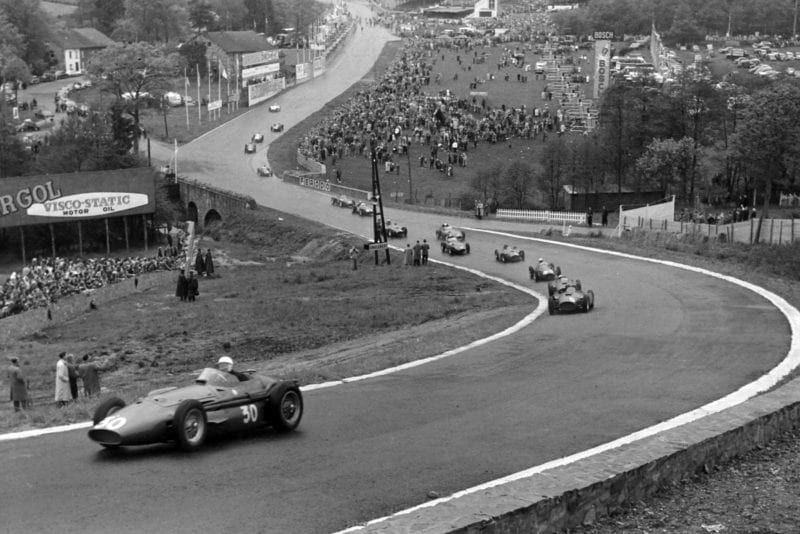
Moss streaks away from the pack at the start
Motorsport Images
On Sunday the rain returned and the cars were lined up on the grid in a very damp atmosphere. Maserati had decided not to use their fuel-injection engine as the consumption was too high and nowadays there is no time for a refuelling stop. Consequently, the sleek new Maserati was fitted with a normal carburetter engine for Moss to use, and in view of the bad feeling he had caused between the two Italian teams Hawthorn decided not to drive at all.
All 15 starters got away as the flag fell, though Fangio was slow off the mark and by the L’Eau Rouge bridge Moss was leading, followed by Collins, while Castellotti and Behra carved-up Fangio as they took the left-hand bend. Away over the hill went Moss, with the rest in hot pursuit and as the tail-enders took the left-hand bend at the top of the Burnenville Forest there was a slight shuffle during which Scotti went sideways, and Godia in avoiding him pressed the wrong pedal and shot off the road. Having broken his own car in practice he was using the spare factory car, the long-nose prototype, and it had the pedals the opposite way round to his car, hence the error.
Scotti was in trouble with his brake mechanism and stopped at the end of the lap for adjustments, and meanwhile Moss was forging along with the three Lancia/Ferraris in hot pursuit. At the end of the second lap Moss was 4 seconds ahead of the Maranello trio who were in a tight bunch in the order Castellotti/Fangio/Collins. Already there was a long gap and then came Schell, Trintignant, Behra and Frere in close company, while at the back Gould led Perdisa, Pilette, Rosier and Villoresi; Scotti still being at the pits.
On lap three, when Fangio got past Castellotti, Moss was 6.5 seconds ahead, but this did not worry the number one Ferrari man and he carved this down to 3 1/2 seconds the next lap and on the fifth time round he was in the lead. Now there was nothing Moss could do and lap after lap the gap widened, and the other two Ferrari team men dropped back and settled down to consistent running. Trintignant took the lead of his foursome, the two Vanwalls going well, but then he suffered a loss of power and called at the pit, leaving Behra well ahead in fifth place, with Schell and Frere very close together for sixth place.
This little dice between the Franco-American in the British car and the Belgian in the Italian car became quite heated and they went past the pits side by side. Eventually, Frere got the lead, and becoming more and more used to the car he began to pull away from the Vanwall. The rain stopped and the track began to dry, so that speeds increased and it was Collins who was first to break the existing lap record, covering his ninth lap in 4 min 19.9 sec, and the race seemed to be settling down.
“Fangio was 8sec in the lead, but then the whole race changed its character in a flash”
Fangio still led, with Moss 6.5 seconds behind, then came Collins at 15.5 seconds, having passed Castellotti, who was now 10 seconds farther back. After these there was a long gap before Behra, Frere and Schell arrived, the rest being lapped by now. As they went over the L’Eau Rouge bridge after the 10th lap Fangio was 8 sec in the lead, but then the whole race changed its character in a flash.
As Moss went up the climbing sweep after the pits, his revs went up and there was no drive to the rear wheels. At the time he was doing about 80 mph and he free-wheeled up the steep hill with what appeared to be sheared transmission, but then the car started to weave and as he went over the hump at the top the left rear wheel, complete with hub and brake drum, came off and bounded across the road. Fortunately he was coasting as it happened, for with the brake drum going the brakes vanished as well and he was lucky to slide to a standstill on the right-hand grass verge.
Almost at the same instant, Castellotti drew into the pits and retired with a broken transmission, so that all this panic left Collins in second place, with Behra third. Without waiting to look at the damaged Maserati (actually the left-hand hub shaft had sheared between the bearings in the end of the de Dion tube) Moss sprinted back to the pits, while a mechanic rushed off to the Source hairpin to flag Perdisa into the pits. Perdisa had been lapped by Fangio and was so far back that Moss had plenty of time to regain the pit, where he took over the third Maserati team car and set off in sixth place. Not knowing of the drama that was going on behind him, Fangio was still pressing on and set the lap record to 4 min 17.4 sec and two laps later reduced it by another tenth of a second.
Fangio was leading Collins by 30 seconds and Behra by 2 min 20 sec, while Moss was a whole lap and 40 seconds behind the leader. He was now lapping at exactly the same speed as Fangio, so that though he crept up on Collins he got no nearer the leader. By this time Gould had retired out on the circuit with a seized gearbox. Trintignant gave up at the pits with an untraceable loss of power and Scotti withdrew due to a lack of oil pressure in the preselector gearbox. Moss came up on the tail of Collins, though still a whole lap to the rear, and Collins wisely eased up and let him go through, playing safe for second place.
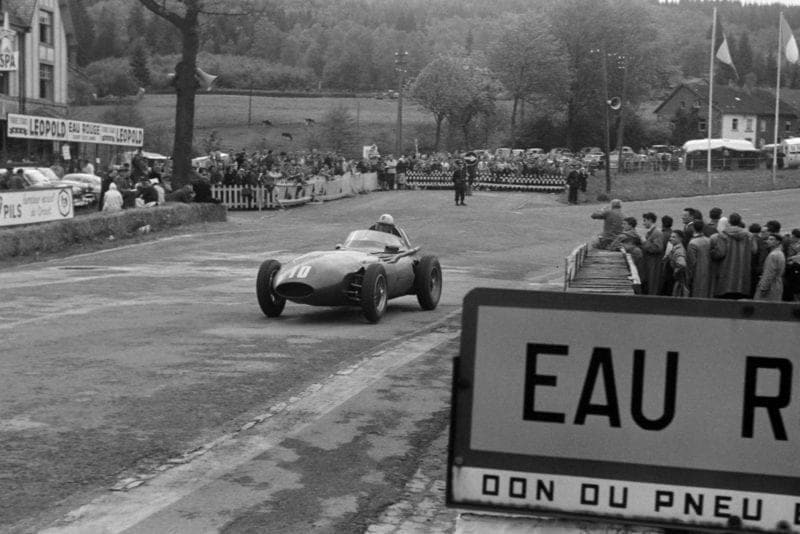
Schell pushes on past the watching crowds
Motorsport Images
There were now two interesting duels going on, the first between Behra and Frere and the second between Schell and Moss. Frere was making a second a lap on Behra and closing relentlessly, while Moss was galloping up on Schell. The Vanwall was not handling well on the high-speed corners, especially those with bumpy surfaces, the steering being so high-geared that it was proving difficult to keep the car on line.
However, what the Vanwall lacked in Grand Prix type circuit handling it made up on speed, and Moss eventually went by on the downhill swerves to Malmedy; he was visibly shaken when Schell overtook him again down the Masta straight so fast that it was impossible to get the Maserati into the Vanwall’s slipstream. However, the long curve at Stavelot was another matter, and Schell prudently eased off and waved Moss by before they reached the corner, for there was no point in baulking the Maserati round the swerves.
“What the Vanwall lacked in Grand Prix type circuit handling it made up on speed”
On lap 24 all eyes were on Frere who was now only 2 seconds behind Behra, and no one was paying attention to Fangio who seemed all set to win, but on this lap he coasted to a stop just out of the Stavelot bend for the transmission had given up and as Collins went by he realised he was now leading, and with the team leader stopped at the opposite end of the circuit to the pits there was no hope of his car being taken away from him, as at Monaco.
With a feeling of relief he waved to Fangio each time he passed, knowing now that providing he did not make any mistakes the race was his, for Moss was too far back to be a danger. Just as all this was happening Frere got past Behra at Burnenville, much to the delight of the large Belgian crowd. Frere was driving the Lancia/Ferrari in impeccable style, but at the same time Behra was running into trouble and his engine was losing its tune, whereas the other works Maserati was singing along, Moss now being fourth, but almost a lap behind Collins; in fact, as Moss reached the top of the hill towards Burnenville Collin’s was rounding the Source hairpin.
Schell was still holding fifth place, followed by Villoresi, Pilette, not at all at home in the yellow Lancia/Ferrari, and Rosier contentedly bringing up the rear. On lap 30, with conditions improving all the time, Moss put in a new lap record in 4 min 14.7 sec and this was interesting for Perdisa could not improve upon 4min 35sec with this same car; also, it was 200 rpm down on the sleek-bodied one Moss had driven earlier in the race.
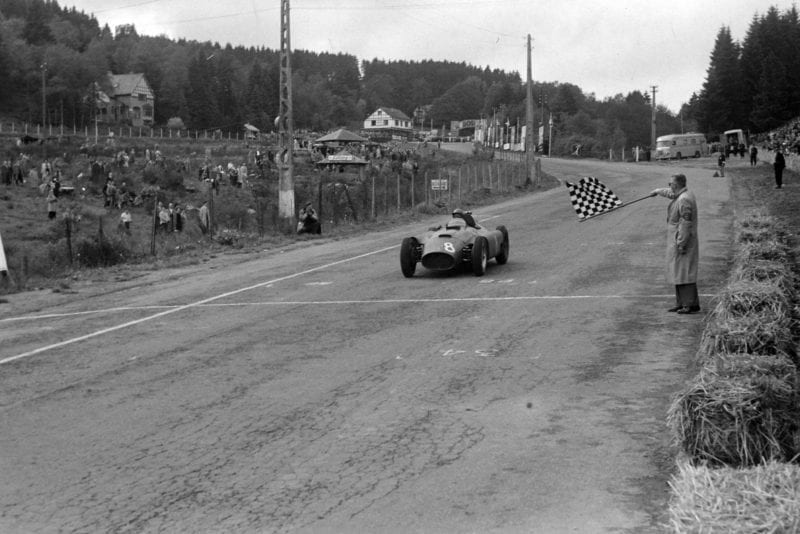
Peter Collins crosses the line to win
Motorsport Images
As he did this fast lap Behra came slowly down the hill to the pits and enquired how many more laps to do, as he motored by, for his engine was failing rapidly. Two laps later he stopped for a time before the finishing line, but then went on again for one more slow circuit. The two Lancia/Ferraris of Collins and Frere now had complete command of the race, for try as he might Moss had no hope of catching up, but like all top-line drivers he continued to press hard all the time.
These three were alone on the same lap, and finally Collins crossed the line a safe and deserved winner in this race of surprises, followed by Frere, who naturally received a warm ovation, and Moss for whom the crowd cheered loudly, being appreciative of one who tries hard. The remainder were flagged in and Behra crawled over the line with his engine making horrid clanking noises and about to fall into little pieces.
Notes On The Cars At Spa
It was the Maserati team who produced the most mechanical interest at Spa and altogether they brought along six cars. One of these had the radiator extended farther forward inside a long tapering nose, and after the air had passed through the cooling element it was deflected upwards and out of the bonnet just in front of the engine, so that no hot air went into the engine compartment. On this car, which was one of the Monaco team, the header tank for the cooling water had been moved to a position on the bulkhead.
Another earlier team car had been completely rebuilt and fitted with an entirely new body, this having a similar system of ducted radiator cooling, much more neatly carried out, but with the header tank still part of the radiator. The cockpit sides of this car were very high, at shoulder level, and the wrap-round screen was somewhat similar to the Vanwall.
This car had a long tapering nose, well shaped and no doubt providing much better initial penetration than the normal 250/Fl Maserati. Into this rebuilt car was fitted a fuel-injection engine, but this unit was also modified. Instead of the injectors squirting fuel into the ports as previously tried out, they were now screwed into the head just below the exhaust ports and injected directly into the cylinders, the same system of chain-driven fuel-injection pump and vertical sliding barrel throttles being retained.
The other four cars were normal 250/Fl models, the one being driven by Behra having the new type of cylinder head with 10 mm sparking plugs as used by Moss at Monaco. The sixth car was a brand new one, quite standard in all mechanical respects, having been completed for the Spanish driver, Francesco Godia, but having a new type of front wishbone which was made from I-section steel instead of the more usual circular section material. Villoresi had on loan the car normally driven by Piotti.
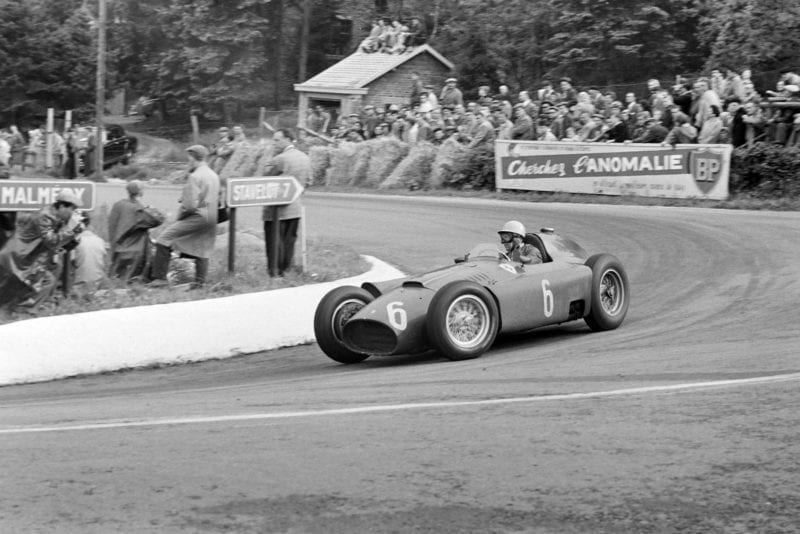
Frere takes the hairpin in his Ferrari D50
Motorsport Images
Of these six cars cared for by the factory, three had the accelerator pedal on the right of the brake pedal and three had the normal Maserati arrangement of the throttle on the left of the brake pedal. The right-hand-throttle cars were for the team leader, Stirling Moss, who cannot drive with any other type of pedal arrangement, and while he had two cars to choose from, the third was for Perdisa who does not mind where the pedals are.
This arrangement was to allow Moss to take over Perdisa’s car should his own break down during the race. It is not possible for him to take Behra’s car, as the Frenchman prefers the accelerator on the left of the brake pedal, though he can drive with the other arrangement if pressed. In addition to these six cars being looked after by the factory there were the private ones of Rosier and Gould, and all except Villoresi were using the normal twin-pipe exhaust system, which is thought to give more power at the top end over the single large-diameter pipe.
Ferrari, on the other hand, was quite satisfied with his V8 Lancia cars, as used at Monaco, and brought along five models, all with the full-width “Syracuse” type of bodywork and bunched megaphones on each side. Four of these were for the factory team and the fifth was painted yellow and was on loan to the Equipe National Belge for the occasion of this race, though it was looked after by the factory mechanics. Outwardly, there was no change in the mechanical details, all had the normal Ferrari-modified de Dion rear end and the engines were still using double-choke downdraught Solex carburetters, but were said to have an increase in power since their last appearance.
The only other team present was the Vanwall and they had their original two 1956 cars running as previously, while there was the lone “Syracuse” model Connaught of Scotti, now repainted green and entered by the Connaught factory. No Gordinis were running as Gordini still does not see eye-to-eye with the Belgians, and anyway was busy preparing sports cars for forthcoming events, knowing that his eight-cylinder models would be very outclassed on the high-speed Spa-Francorchamps circuit.
Spa Spotlights
- An unexpected tribute to the late John Heath was the fact that the first three drivers to finish had their first experience of “monoposto” road racing on HWM cars.
- As Grand Prix car design progresses it is becoming more and more difficult for drivers to get into their cars. The Vanwall and latest Maserati having very high cockpit sides and Lancia/Ferrari demanding very long legs to step over the wide sides. Trintignant’s entry into the Vanwall is rather akin to mountain climbing.
- After muddling about badly at the beginning of the season, Maserati seem to have found their feet again and are making big efforts for the World Championship races. The broken hub-shaft on the Moss car was something that has not happened before.
- Down the fast Masta straight the Lancia/Ferraris were geared to do approximately 165 mph at 8,200 rpm so that absolute maximum reached was probably 170 mph.
- A pity that Hawthorn’s talents are still being wasted due to various small side-issues. Let us hope the BRM hurry up and get him a car worthy of his ability, for he has already missed two Championship events.
- This does seem to be a Collins year, his successes being mostly the result of consistent and sensible driving and doing what he is told by the team chief.
- Ironical that the only Italian driver to finish the race was grey-haired Villoresi, who can still drive well, if not as fast as the top boys.
- The World Championship after this event saw the remarkable state of affairs of two British drivers in the lead, Moss and Collins.
1956 Belgian Grand Prix race results
1. Peter Collins (Ferrari) 2:40:00.3
2. Paul Frere (Ferrari) + 1:51.3
3. Cesare Perdisa/Stirling Moss (Maserati) + 3:16.6
4. Harry Schell (Vanwall) + 1 lap
5. Luigi Villoresi (Maserati) + 2 laps
6. Andre Pilette (Ferrari) + 3 laps
7. Jean Behra (Maserati) + 3 laps
8. Louis Rosier (Maserati) + 3 laps
9. Juan Manuel Fangio (Ferrari) Retired – Transmission
10. Maurice Trintignant (Vanwall) Retired – Fuel system
11. Stirling Moss (Maserati) Retired – Wheel
12. Eugenio Castellotti (Ferrari) Retired – Transmission
13. Piero Scotti (Connaught) Retired – Engine
14. Horace Gould (Maserati) Retired – Gearbox
15. Paco Godia (Maserati) Retired – Accident
Championship Standings
1. Peter Collins – 11
2. Stirling Moss – 11
3. Jean Behra – 10
4. Juan Manuel Fangio – 9
5. Pat Flaherty – 8
